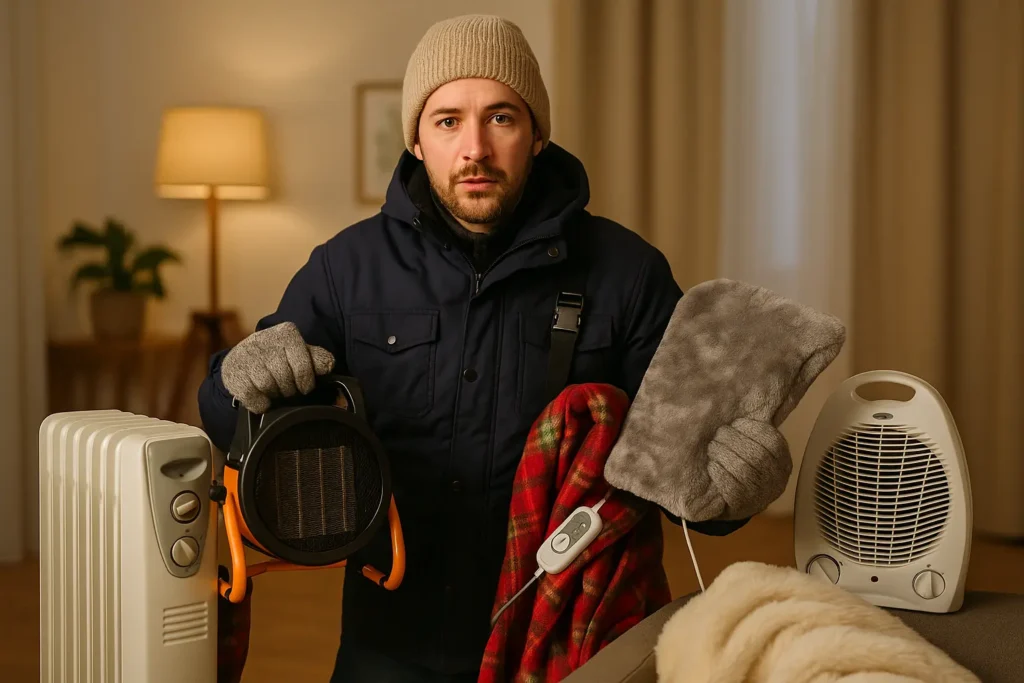As a technician who’s worked on heating systems and home comfort products over the years, I’ve seen the difference the right accessories can make in turning “brrr” into “ahhh.” This guide takes a closer look at the best heating accessories for winter, with technical tips and advice to help you decide on your next purchase. Let’s go through these must-haves together and get your home toasty, safe, and efficient.
-
Smart Thermostat Plug for Portable Heaters
If you are using a portable electric heater, you can make it smarter with a Wi-Fi thermostat plug. These nifty devices let you operate your heater with your phone or even with voice assistants like Alexa or Google Home. Its temperature control range is between 5°C and 35°C, so you can tailor it to the exact warmth you wish — and the plug will cycle it on and off to keep it programmed.
What sets these smart plugs apart is the included scheduling, geofencing, and energy usage tracking. They also come with overheat protection, so they don’t just make your heater smarter; they make it safer. But if you’re after the best in comfort and energy savings, get a smart thermostat plug for portable electric heaters.
-
Wood Stove Fan – Heat Powered
For anyone who heats with a wood or pellet stove, a heat-powered stove fan can be a surprisingly valuable tool. It rests on your stove and employs a thermoelectric module to turn heat into electricity, easily turning the blades with no batteries or cords. This fan then disperses that warm air across the room, eliminating cold spots and allowing your stove to heat the room quickly.
These fans run at 50C to 350C, up to 300 Cubic Feet per Minute (CFM), and sound half as loud as your PC’s graphics card, at only 25 decibels. The anodized aluminum blades are heat-resistant, so you’ll never have to worry about them bending or warping the next time you’re making a batch of homemade ice cream. Based on my experience, installing a heat-powered wood stove fan can improve the distribution of heat by up to 30%. This is an intelligent and environmentally friendly option for off-grid or rural homes, well worth the investment.
-
Thermal Insulated Curtains for Winter Energy Efficiency
If your house feels chilly despite the heater being on, the issue might not be your heating system, but your windows. That’s where the thermal insulated curtains come in. These specially engineered curtains often feature multiple layers of triple-weave polyester or microfiber, enhanced by thermal foam or blackout lining, which serves as a barrier to keep warm air in and cold air out. Studies from the U.S. Department of Energy found that insulated curtains can decrease heat loss as much as 25%, particularly during the evening when warm air escapes through a window that isn’t insulated.
They’re not only more thermally efficient but also keep out drafts, reduce noise, and provide UV protection. The majority of brands have an R-value of at least 3–4, so you’re adding a layer of insulation that can actually be measured to your windows. They’re a no-electronics-required upgrade that works great with any heating system and can save you even more money on your heating bills. If you would like an inexpensive energy-saving winter heating accessory, thermal curtains are an elegant and efficient option.
-
Rechargeable Heated Insoles for Cold Feet and Outdoor Work
Cold feet are not only uncomfortable, but they can also chill your entire body, particularly during long outdoor periods or when commuting early in the morning. That is where rechargeable heated insoles come in handy. These tiny, wearable foot warmer accessories deliver indirect heat to the soles of your feet through an integrated carbon fiber or nickel-chromium alloy heating element, which warms to a max of 50 °C (122 °F). Wireless remotes, as well as USB or Type-C charging, are featured on many models for anywhere between 4 and 8 hours (on one charge), depending on heat standing.
Some sophisticated models even come with temperature control sensors and can be cut to match any shoe size without harming the heating cables. They’re great for tradies, couriers, snow campers, or anyone else walking in sub-zero deliveries. A 3.7V – 7.4V lithium-ion battery provides safe, low-voltage power, so there’s no danger of overheating. However, if you need a heated insole for use during the winter or on freezing days at work, this is among the most useful personal heating accessories you can find.
-
Electric Foot Warmers and Heated Foot Massagers
Warm feet can be the perfect solution when all you need is an instant feel-good moment—especially if you work from home or spend long hours sitting. And that’s where electric foot warmers or heated foot massagers come in. These portable and easy-to-use warmers deliver continuous warmth around 40 55°C and are perfect for enhancing your blood flow and comfort at home. Some models also feature soft fleece or plush fabric interiors, adjustable heat settings, and auto shut-off for safety.
Some double as kneading or vibration massagers, which are perfect for soothing tired or cold feet. The great majority plug into standard power outlets and are rated at 100 to 150 watts, which is a powerful — but safe — amount. Also, you’ll want to find a model that’s ETL or UL-listed, which means it complies with North American electrical safety standards. If you want a safe foot warmer with auto shut-off in winter for the family, this foot warmer is ideal for bedrooms, lounges, or homes.
-
USB Heated Desk Pads for Home Office Warmth
If you’re at your desk for hours and have problems with cold hands or wrists, a USB heated desk pad is an underrated but brilliant solution. The leather-like, slim mats go under your hands, keyboard, or arms, and heat fast via 5V or 12V USB power. Typically, they have adjustable heat settings that cycle between 30 °C and 60°C and auto-off features (typically after 2 to 4 hours).
They’re energy-efficient as well, typically requiring just 8 to 15 watts of power, and some models are also water-resistant so that you can use them as a slick mouse pad or protected writing surface. That makes them great for telecommuters or children in the winter. Whether you are typing emails or crafting your blog, a USB heated desk pad for cold workspaces helps you concentrate and stay warm without needing to fire up a big room heater.
-
Heated Blankets
Because there’s really nothing like cuddling up under a warm blanket on a cold winter night, heated blankets are an ideal personal solution —comfort meets energy efficiency. With several heat settings, each setting allows you to get the level of heat you need to feel comfortable, whether you’re simply warm or downright hot. Auto-shutoff to prevent overheating, save energy, and a machine-washable cover for easy cleaning. These blankets typically use about 50-150W of power, so they are much more eco-friendly than space heaters.
They come in fleece, microfiber, or cotton, and offer different levels of softness and warmth. Most blankets operate on low voltage to provide safe, continual warmth. They are really energy efficient, easy to carry and lightweight, confined to single use, and their appearance can be gone after many washes. Electric blankets are great for your beds, couches, and personal spaces, so you can enjoy the comfort and warmth of any home, regardless of what you like to do around your house.
-
Energy-Efficient Heated Mattress Pads
For keeping warm at night, one of the wisest picks is a heated mattress pad. These pads aren’t like electric blankets that drape over your body — they reside beneath your sheets, beaming heat up at you as you slumber. Most of the models we tested work on low-voltage radiant systems, meaning they draw much less power — from 60 to 120 watts per side — than space heaters. Most come with 10 to 20 heat settings, which can be adjusted, dual controls for couples, and preheat functions to warm the bed before you climb in.
Bonus: the majority of heated mattress pads are machine washable and feature auto shut-off timers for extra safety. (They’re especially useful for people with arthritis or other poor circulation, and they let you turn down your central heating without losing all that warmth.) If you are in search of all-over warmth this winter and you are energy-conscious, this heated mattress pad will fit the bill.
-
Energy Monitoring Plugs
They also include apps from adjacent companies, like the TP-Link Kasa or Eve Energy, that monitor the power usage of specific appliances and let you control them remotely or schedule them for shutdown. They’re especially beneficial for high-use devices such as space heaters or heating blankets. In addition to providing real-time usage stats, they send notifications about waste and can even turn the power on and off as needed to avoid it. This is an add-on that can pay for itself quickly by simply cutting phantom loads that all of us tend to ignore.
-
Thermal Leak Detectors
It is crucial to identify and eliminate drafts before attempting to improve a heating system. Products such as the FLIR TG165-X and Black & Decker TLD100 employ thermal imaging to detect insulation deficiencies. They can find temperature variances of up to 0.1°C, and they’re critical for identifying hot spots. You can save up to 10 percent on heating costs when leaks are sealed, which makes this the most efficient first step in energy conservation.
-
Heating Pads – Modern Targeted Heat Therapy
Suppose you have pain and stiffness in your neck and back. In that case, I am a sentence, and back have a way of cuddling up with you almost literally, and attaching themselves to you, you may be among the millions of people who derive soothing comfort and welcome relief from pain, stress, and tension from a heat therapy pad.
When central heat won’t do, or when you’re seeking targeted warmth, heating pads can provide a more flexible, low-energy option. You may prefer a large (usually 100x50cm) full-body heating pad for the back, belly, or legs, with integrated temperature control and a rapid heat-up function for quick comfort. They are perfect for people with muscle stiffness or for individuals who suffer from chronic pain, as they provide a constant source of warmth without the size of space heaters.
For more targeted relief, heating pads for neck and shoulders are shaped to conform to the cervical spine and upper traps, offering tension relief for long work days or bad posture. Some models even add vibration therapy into the mix, giving you a heating and massage pad designed to circulate blood while relaxing deep tissue. Or you want a warm butt on the couch, trying to manage pain, or just a back of the couch butt – either way, these pads are a smart, energy-efficient addition to your winter comfort toolkit.
Conclusion
As a technician, I’ve found that the right heating accessory can be a game-changer when it comes to winter. Whether you want instant heat like you get from a space heater or extra coziness like you get from underfloor heating systems, there is an option here for you. When selecting, always choose safety, energy efficiency, and compatibility with your space. In these accessories, you’ll bear the weather — no matter how cold it is outside.

